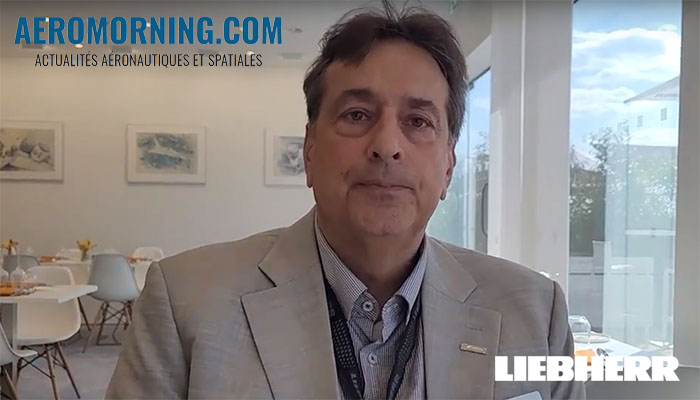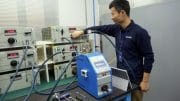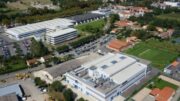Interview Alex Vlielander Liebherr-Aerospace & Transportation SAS – Chief Customer Officer
AeroMorning : Wich novelties is presenting Liebherr-Aerospace to the Le Bourget Airshow 2025 ?
For current status of innovation and what’s available for the Liebherr product lines, I would say lightweight, miniaturization, and a move towards a more electrical aircraft. What I mean by that is we’re moving from a analog, pneumatic type environment to a more electrical, electronic aircraft, and that’s the direction that our systems are going.
AeroMorning : What are Liebherr-Aerospace & Transportation SAS items under development for the next years ?
In regards to the innovation of tomorrow, I think the issue here is that we need to understand as a supply chain organization, because we are part of a bigger ecosystem, what the next generation of power plants are going to be, because that’s really what’s going to drive us, at least for the flight controls and the environmental control systems that we’re on, what the challenges are going to be because of the power plant.
The landing gear, of course, is a different story. That’s more independent of what the technology status is going to be. But is it going to be a more electrical aircraft than we already see? Is the power plant going to be of a specific type of propulsion, meaning how are we going to see hydrogen?
Is it going to be a more electric, is it a more sustainable fuel type environment? I think that’s going to help us determine what the next generation of technologies are going to show us. So at this point in time, it’s more of a wait and see to see which way we are developing.
Of course, as an engineering firm, we anticipate and we develop programs that we think may be of interest. But I don’t think it’s opportune at this point in time to share exactly what it is we are working on, because there are so many unknowns at this point in time.
AeroMorning : What are the Liebherr-Aerospace & Transportation strong points versus competition ?
As a European OEM, obviously we abide by reach, compliance and any other environmental control and compliance that we are faced with. We don’t wait until people tell us what to do. Once we see the specifications that are coming up, we anticipate and we try to find alternatives so that we do not have to engage last minute.
The sooner you start adapting to the changes in the compliance, the easier and cheaper it is in the end. So for us it’s important to understand which direction we are going, anticipate as much as possible what the final regulation will look like and then implement that.
As a relatively small OEM, I do think we managed to win new business continuously because of our agility. Being smaller allows you to be more agile. I think also our unique perspective in a product life cycle, so for us it’s not just interesting to develop a new technology, a new product, manufacture it, and then provide it to the aircraft OEM.
For us, it goes more than that. It’s also about the product support through its lifetime. So I think where we excel is developing, designing, producing, and then supporting the products for the actual operator, be it an airline, a cargo operator, or an individual operator.
So I think the key success factor for Lieber is being able to provide a product at its inception through its maturity, and once the product is in the field, provide aftermarket support.
AeroMorning : How is your supply chain going ?
Obviously coming out of COVID, like most every other system supplier or component supplier at the lower level, or a tier 2 or a tier 3, we had serious impacts on the supply chain, meaning small and medium sized companies in particular,
sometimes had trouble to continue to invest or to even procure parts. So we’ve taken the step to support our sub-tiers, sometimes by buying their inventory in advance or even succumbing people in support of their production processes.
What I can tell you is that I believe that the worst of the supply chain constraints is over. That still means that we have issues with the supply chain. However, it is not a structural. What I see now happening is most of the supply chain is back on track.
however the availability of manpower to complete the products is now finished. I’ll give you for example, we used to have a lot of work stops because we didn’t have parts. Now that the parts are available we can complete the parts but now we don’t have enough manpower to complete the backlog.
The other thing that I think we need to realize is that we have a very fragile supply chain because of the let’s say smaller quantities of production runs it’s more difficult to find second or even third sources.
As a result the lower volumes in production runs sometimes are a risk for our sub suppliers and they will decide that running a limited production versus for example a bigger production run for an automotive type environment is not that advantageous.
So our critical concern going forward is making sure that the sub-suppliers, that the raw material suppliers still have an interest in developing and producing lower volumes. In regards to the health of the supply chain and are we back to our standards pre-COVID, I think the telltale sign will come once Airbus is able to go to the rate 75, which means if Airbus is capable of producing 75 A320s a month,
they produce of course in Toulouse, they produce in Hamburg and produce in China. If Airbus can definitively produce 75 aircraft a month, which is what they’re aiming for, then we can for sure say that the supply chain has recovered.
AeroMorning : What about predictive maintenance at Liebherr-Aerospace & Transportation SAS ?
With our health monitoring and predictive maintenance algorithms, we can ensure that the operations run smooth and uninterrupted, meaning that on time products can be removed, serviced before they cause operational interruptions.
Worthwhile to mention our Liebherr’s health monitoring algorithms and even our predictive maintenance algorithms. As a designer, manufacturer and then maintainer of products, we believe that we have a very very good position to develop health monitoring, basically the word describes it.
We monitor the status of the products and say safe to fly. A step further is of course the predictive failure algorithm. Here based on key inputs of the data provided by the downloads of the airframer, we can establish a failure pattern.
and perhaps anticipate the removal of a component before it actually fails on-wing perhaps leading to delays, cancellations of flights. So with our predictive and health monitoring algorithms we enable operators to optimize their on-wing reliability.
AeroMorning : How does Liebherr compete with big companies like RTX, which are able to provide complete systems ?
So for us it’s not just interesting to develop a new technology, a new product, manufacture it, and then provide it to the aircraft OEM. For us it goes more than that. It’s also about the product support through its lifetime.
So I think where we excel is developing, designing, producing. and then supporting the products for the actual operator be it an airline, a cargo operator or an individual operator. So I think the key successful factor for Lieber is being able to provide a product at its inception through its maturity and once the product is in the field provide aftermarket support.
By Nadia didelot for AeroMorning.com









Be the first to comment on "Interview Liebherr Aerospace At Le Bourget 2025"